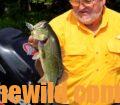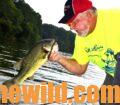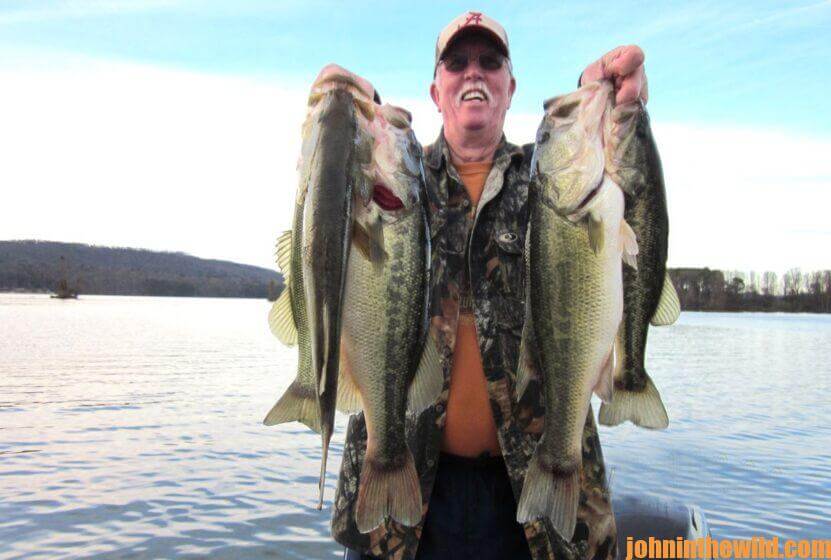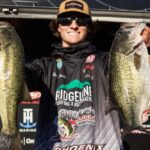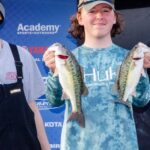Editor’s Note: Captain Phillip Criss of Scottsboro, Alabama, has been a more-than a three-decade fishing buddy of mine for both bass and crappie – first at Miller’s Ferry and now at Lake Guntersville (www.guntersvilleal.org) on the Tennessee River in north Alabama. Anglers across the South know of Criss’s bass-fishing expertise. Since he’s retired from his day job to move to Guntersville to guide and fish, in mid-July, I went fishing with him. Criss gave me valuable information on fishing grassy lakes in hot weather. Guntersville is known as one of the top-5 bass-fishing lakes in the nation, primarily because of its grassy habitat that produces and grows bass.
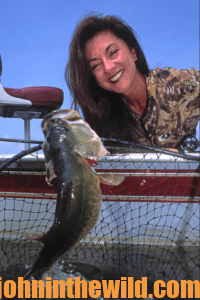
“We’re about to transition from the tail end of summer (August) and the beginning of fall – September and October,” Captain Phillip Criss explains. “Frog fishing is one of the most-exciting ways to catch bass. Frog fishing in the summer may produce a bass of a lifetime. However, where I frog fish, most anglers don’t want to go to those areas because many of these places are loaded both with mosquitoes and bass in the summer months. But once the weather cools-down in early November, that’s when frog fishing in the grass really turns on at Lake Guntersville. I look for the thickest grass mats I can find, and/or the grass mats that already have died or are starting to decay and have foam over the top of them. These kinds of mats kind of look like green slime. When there’s an inch or two of green slime on top of the water, we know the grass under the slime already has rotted and started to die. These mats are best fished on a real bright day. To identify the most-productive slimy mats to fish in grassy lakes, cut your big engine off, turn off your trolling motor, and listen for bream smacking under and on top of the grass. Next, start looking at those mats for what we call blow holes that are 1 to 3 feet in diameter on top of the grass. When you can locate this kind of grass mat with a hole in it, you almost can bet money you’ll catch a bass out of that hole.
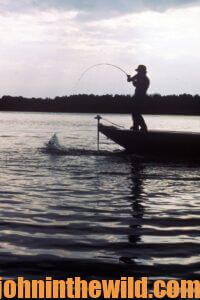
“Those blow holes are created by a bass coming up under the mat and attacking a bream that’s feeding right at the surface of the water. I’ve seen bass before blow bream 1-2 feet high on top of the grass. That bream will be flopping on top of that green slime, and you’ll see the slime start to hump-up, because the bass is underwater trying to get to the bream flopping on top of the grass. When the bass gets close enough to the bream, the bass will make a hard run, blow through the grass again and eat the bream. There doesn’t necessarily have to be a hole in the grass to catch a bass. When you’re fishing a rubber frog on top of the grass, and you see the grass starting to bulge, hold on to your rod, because a bass is about to blow-up on your rubber frog. The bass will create a hole to come through the grass and eat the frog, if there’s no hole available.
“A lot of fishermen think the color of the frog makes a lot of difference, but I don’t. You have to remember, when a bass sees a rubber frog coming across the grass or slime, really all he’s seeing is a shadow of a frog. I like to fish a frog that’s yellow on the front half and black on the back half, a solid-black frog or a solid-white frog. I like the Snag Proof frog (http://www.snagproof.com/) and the Spro frog (http://www.spro.com). I fish the frog on 65-pound-test braided line with an extra-heavy rod. When fishing the frog, the real problem is not to set the hook after the bass explodes on it. Many times, the bass will blow-up on a rubber frog and won’t get the frog in its mouth but will circle back around and attack what the fish believes to be an injured frog. So, when you see a bass attack a frog, count to two, and set the
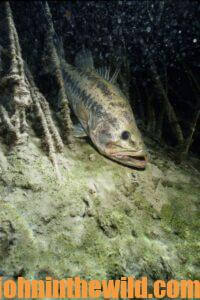
hook, or wait to see if your line moves off after the bass attacks the frog, or if you can feel weight on your line after the bass attacks. Most of the time, if you’ll wait until the count of two before you set the
hook, you’ll catch about 95 percent of the bass in the grass that attack the frog.
“The average person who fishes at Guntersville probably will lose one out of three bass that attack his baits, if that angler strikes a bass like he will on most lakes in the country. When the bass comes up, shakes its head and throws the hook, anglers don’t understand why they’ve lost their bass. The comment I hear so much is, ‘That bass just didn’t have the lure in its mouth good.’ But
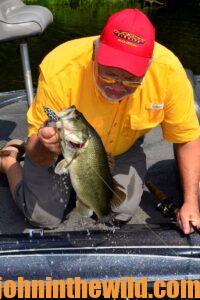 really and truly he probably did. The angler just didn’t set the hook hard enough. Sometimes when you have a bass that weighs from 3 to 5 pounds, take a quality bass hook, and try to stick that hook in the bass’s mouth. Bass have really-tough skin inside their mouths. I tell my fishermen the bass’s mouth is like shoe leather and may feel soft and pliable, but it’s really tough to penetrate.
really and truly he probably did. The angler just didn’t set the hook hard enough. Sometimes when you have a bass that weighs from 3 to 5 pounds, take a quality bass hook, and try to stick that hook in the bass’s mouth. Bass have really-tough skin inside their mouths. I tell my fishermen the bass’s mouth is like shoe leather and may feel soft and pliable, but it’s really tough to penetrate.
“Also, if you’re fishing a lure like the Zoom Magnum shaky head lures that I fish, you’ve got a big lead on the front of that hook. When the bass shakes its head, that weight flops around and works a bigger hole in the bass’s mouth, and then the fish can throw the lead. If your hook doesn’t penetrate all the way through the bass’s mouth, the hook easily can work its way out of its mouth. If you’re fishing a big crankbait, you also have a good bit of weight in that lure that will cause a bass to shake that lure and make the hook come out. Sometimes, I think those bass have hands and can reach inside their own mouths and pull the hooks out.

“Another problem on Lake Guntersville and other grass lakes, especially in the summertime when you’re fishing baits like the Magnum Trick Worm or jigs, is often a big bass won’t attack the lure very aggressively. You may feel a tick on the line, or the line may just feel a little heavy or somewhat spongy. To make sure there’s a fish on the line, the fisherman pulls his rod up and then tries to set the hook. So, he’s only applying half the force on the line that he could have applied if he’d reeled down, getting his rod tip closer to the water before he sets the hook. Big bass have all kind of ways to escape fishermen. I’ve seen them escape just about every way they can. “When I see my angler has a good bass hooked, I’ll tell him to set the hook again. You can set the hook the second time, if you’re using 14-17 pound test line or larger. But more than likely, if you try to set the hook the second time with 10-12-pound test line, you’ll break the line. Also, you’ve got to have power in your rod. I like a medium-heavy 7- to 7-1/2 foot worm rod. This type rod helps you get a long cast and a good, solid hook set.
“One of the things that first-timers to Guntersville may not realize is there’s a good bit of current that comes through this lake. You can call the generating plant, and they’ll tell you how many generators they’ll have running, and how many cubic feet of water they’ll be pulling through the dam. Idealistically, you want 30,000 cubic feet per minute or more coming through the dam. But if they’re pulling 30,000 cubic feet per minute out of Guntersville Lake and putting 40,000 cubic feet or more water into Guntersville Lake from Nickajack – the dam above Guntersville Lake – then, you really don’t have much current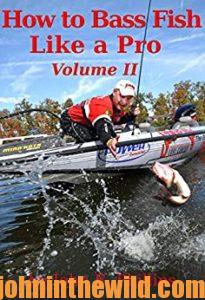 flow. You’re putting more water into Guntersville Lake from upstream than you’re taking out of Lake Guntersville downstream. That being said, if you’re on the upper end of the lake or the lower end of the lake, you’ll experience much-more current than you will in the backwaters off the main river channel. The best current is when they’re pulling 30,000 cubic feet per minute out of Lake Guntersville without dumping water into the lake, and the ledge fishing is the best up here.”
flow. You’re putting more water into Guntersville Lake from upstream than you’re taking out of Lake Guntersville downstream. That being said, if you’re on the upper end of the lake or the lower end of the lake, you’ll experience much-more current than you will in the backwaters off the main river channel. The best current is when they’re pulling 30,000 cubic feet per minute out of Lake Guntersville without dumping water into the lake, and the ledge fishing is the best up here.”
To contact Captain Phillip Criss about fishing Lake Guntersville, call him at 205-461-5549 or email him at [email protected].
To learn more about bass fishing, check out John E. Phillips’ book, “How to Bass Fish Like a Pro, Volume II,” available in Kindle, print and Audible versions at https://www.amazon.com/gp/product/B08Z9W6VC1/ref=dbs_a_def_rwt_hsch_vapi_taud_p1_i9.To learn more about hunting for deer, since deer season starts soon in many states, check out John E. Phillips’ “Bowhunting Deer: Mossy Oak Pros Know Bucks and Bows” available in Kindle, print and Audible as of August, 2022, at (http://amzn.to/1QGvdQx) You may have to copy and paste these clicks into  your browser. When you click on these books, notice on the left where Amazon says you can read and hear 10% of the books for free. On right side of the page and below the offer for a free Audible trial, you can click on Buy the Audible with one click.
your browser. When you click on these books, notice on the left where Amazon says you can read and hear 10% of the books for free. On right side of the page and below the offer for a free Audible trial, you can click on Buy the Audible with one click.
Tomorrow: Understand Grassy Lake Summer Bassing

